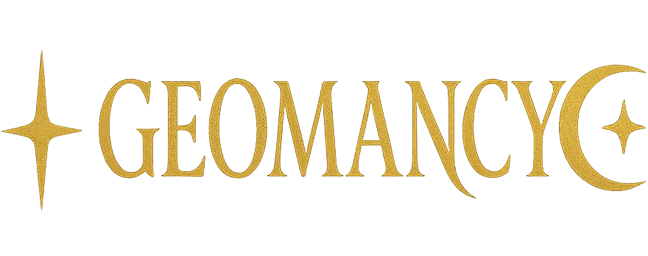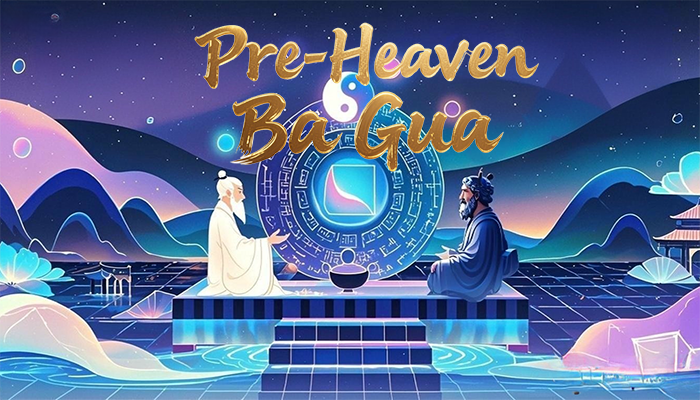Pre-Heaven Bagua: An Abstract Model of Galactic Space
Introduction to Pre-Heaven Bagua
The Pre-Heaven Bagua (also known as the Fuxi Bagua) holds a significant place in Chinese culture. It evolved from the He Tu (River Map) and represents the primordial state of the universe. Unlike the He Tu, which does not define specific directions, the Pre-Heaven Bagua symbolizes the fusion of the two complementary forces of Yin and Yang, reflecting the static balance of cosmic energy. To apply this concept in practical terms, one must understand the origin of the “Pre-Heaven” energy and its alignment within the spatial framework of the universe.
“The legendary sage Fuxi, by observing celestial phenomena, the landscape, and human activities, deduced the laws governing the movement of all things in the universe. He then created the Pre-Heaven Bagua.”
The Pre-Heaven Bagua serves as a structured expression of the energies represented by the He Tu and follows its numerical principles. It embodies the philosophy of the unity between Heaven and Earth: using the trigram Qian (☰) to represent Heaven in the southern direction, and Kun (☷) to represent Earth in the northern direction, showing the dual and interconnected relationship of Yin and Yang energies.
Basic Structure of the Pre-Heaven Bagua
The Pre-Heaven Bagua is made up of Yin (⚋) and Yang (⚊) lines. Through different combinations of these lines, eight basic trigrams are formed:

Spatial Orientation
The arrangement of the Pre-Heaven Bagua follows a pattern of symmetrical balance. The four primary trigrams (Qian, Kun, Li, Kan) are positioned opposite the four corner trigrams (Zhen, Xun, Gen, Dui), which represent the four cardinal directions:
- Qian and Kun represent South and North respectively.
- The corner trigrams correspond to the four intercardinal directions: Zhen (Northeast), Xun (Southwest), Gen (Northwest), and Dui (Southeast).
This structure symbolizes the universe’s most original balanced state.
Core Philosophy
Taiji Generates the Two Forces (Yin and Yang)
The universe initially existed in a state of chaos, referred to as Taiji (the Supreme Ultimate). From Taiji, Yin and Yang emerged as the Two Forces or Liang Yi (Yang as Qian, Yin as Kun).
The Two Forces Generate the Four Images
The Yin and Yang further divide into the Four Images (or Xiang), which are associated with different aspects of cosmic energy:
- Li (☲) represents the Sun (Yang),
- Kan (☵) represents the Moon (Yin),
- Zhen (☳) represents the Lesser Yang,
- Xun (☴) represents the Lesser Yin.
The Four Images Generate the Eight Trigrams
These Four Images then evolve into the Eight Trigrams (Bagua), which symbolize various natural phenomena:
- Heaven (Qian),
- Earth (Kun),
- Mountain (Gen),
- Lake (Dui),
- Thunder (Zhen),
- Wind (Xun),
- Water (Kan),
- Fire (Li).
These trigrams represent the basic forms of nature in the universe and are considered the building blocks of the world around us.
Applications of Pre-Heaven Bagua
The principles of the Pre-Heaven Bagua have many practical applications in Feng Shui layout and the adjustment of energy fields in human destiny. The ancient sages of the Chinese nation left behind a series of mysterious numbers and a poetic verse related to the Pre-Heaven Bagua, awaiting future generations with higher wisdom to extract and apply for the benefit of humanity. The verse reads:
Qian 1, Dui 2, Li 3, Zhen 4, Xun 5, Kan 6, Gen 7, Kun 8;
Heaven and Earth establish their positions, the mountains and lakes communicate, thunder and wind support each other, water and fire do not interfere.
This verse and the associated numbers and trigrams are believed to carry deep cosmic wisdom, forming the foundation of the Pre-Heaven Bagua’s application in Feng Shui and cosmic energy regulation.
先天八卦:銀河系空間的抽象模型
先天八卦簡介
先天八卦(又稱伏羲八卦)在中國文化中佔有重要地位。它由河圖演變而來,代表宇宙的原始狀態。與河圖不同,先天八卦不定義具體方向,而是象徵陰陽兩種互補力量的融合,反映了宇宙能量的靜態平衡。要在實踐中應用這一概念,必須理解「先天」能量的起源及其在宇宙空間框架中的對齊方式。
“傳說中的聖人伏羲通過觀察天象、地理和人類活動,推導出宇宙萬物運動的規律,然後創建了先天八卦。”
先天八卦是河圖能量的結構化表達,遵循其數理原則。它體現了天地合一的哲學:用乾卦(☰)代表南方天,坤卦(☷)代表北方地,顯示陰陽能量的二元互聯關係。
先天八卦的基本結構
先天八卦由陰(⚋)陽(⚊)爻組成。通過這些爻的不同組合,形成了八個基本卦象:
-400x121.png)
空間方位
先天八卦的排列遵循對稱平衡的模式。四個主要卦象(乾、坤、離、坎)與四個角卦(震、巽、艮、兌)相對而立,代表四個基本方向:
- 乾和坤分別代表南和北
- 角卦對應四個中間方向:震(東北)、巽(西南)、艮(西北)、兌(東南)
這種結構象徵宇宙最原始的平衡狀態。
核心哲學
太極生兩儀(陰與陽)
宇宙最初存在於混沌狀態,稱為太極。從太極中,陰陽作為兩儀出現(陽為乾,陰為坤)。
兩儀生四象
陰陽進一步分為四象,與宇宙能量的不同方面相關:
- 離(☲)代表太陽(陽)
- 坎(☵)代表月亮(陰)
- 震(☳)代表少陽
- 巽(☴)代表少陰
四象生八卦
這四象然後演變成八卦,象徵各種自然現象:
- 天(乾)
- 地(坤)
- 山(艮)
- 澤(兌)
- 雷(震)
- 風(巽)
- 水(坎)
- 火(離)
這些卦象代表宇宙中自然的基本形式,被認為是我們周圍世界的構成要素。
先天八卦的應用
先天八卦的原則在風水佈局和人類命運能量場的調整中有許多實際應用。中華民族的古代聖賢留下了一系列神秘的數字和與先天八卦相關的詩句,等待具有更高智慧的後代提取並應用於造福人類。詩句如下:
乾一、兌二、離三、震四、巽五、坎六、艮七、坤八;
天地定位,山澤通氣,雷風相薄,水火不相射。
這首詩及其相關的數字和卦象被認為承載著深刻的宇宙智慧,構成了先天八卦在風水和宇宙能量調節中應用的基礎。

